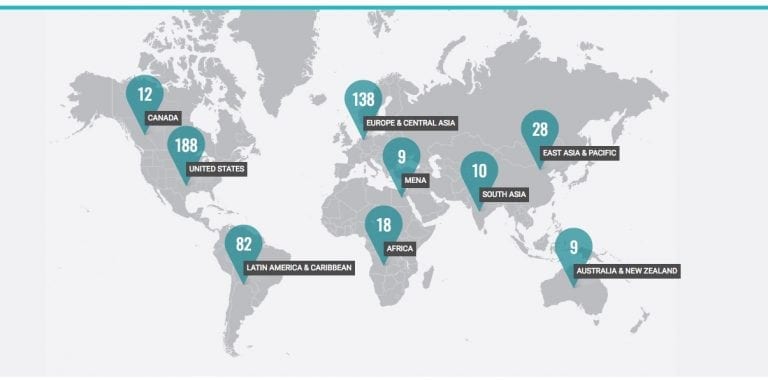This is a slightly revised version of an article published on July 24, 2018, on the website of Science for the People and on MR Online. It was written for the Summer 2018 special issue on geoengineering of the new Science for the People, announcing the magazine’s relaunch.
A short fuse is burning. At the present rate of global emissions, the world is projected to reach the trillionth metric ton of cumulative carbon emissions, breaking the global carbon budget, in less than two decades.1 This would usher in a period of dangerous climate change that could well prove irreversible, affecting the climate for centuries if not millennia. Even if the entire world economy were to cease emitting carbon dioxide at the present moment, the extra carbon already accumulated in the atmosphere virtually guarantees that climate change will continue with damaging effects to the human species and life in general. However, reaching the 2°C increase in global average temperature guardrail, associated with a level of carbon concentration in the environment of 450 ppm, would lead to a qualitatively different condition. At that point, climate feedbacks would increasingly come into play threatening to catapult global average temperatures to 3°C or 4°C above preindustrial levels within this century, in the lifetime of many individuals alive today. The situation is only made more serious by the emission of other greenhouse gases, including methane and nitrous oxide.
The enormous dangers that rapid climate change present to humanity as a whole, and the inability of the existing capitalist political-economic structure to address them, symbolized by the presence of Donald Trump in the White House, have engendered a desperate search for technofixes in the form of schemes for geoengineering, defined as massive, deliberate human interventions to manipulate the entire climate or the planet as a whole.
Not only is geoengineering now being enthusiastically pushed by today’s billionaire class, as represented by figures like Bill Gates and Richard Branson; by environmental organizations such as the Environmental Defense Fund and the Natural Resources Defense Council; by think tanks like the Breakthrough Institute and Climate Code Red; and by fossil-fuel corporations like Exxon Mobil and Shell—it is also being actively pursued by the governments of the United States, the United Kingdom, China, and Russia. The UN Intergovernmental Panel on Climate Change (IPCC) has incorporated negative emissions strategies based on geoengineering (in the form of Bio-energy with Carbon Capture and Storage, or BECCS) into nearly all of its climate models. Even some figures on the political left (where “accelerationist” ideas have recently taken hold in some quarters) have grabbed uncritically onto geoengineering as a deus ex machina—a way of defending an ecomodernist economic and technological strategy—as witnessed by a number of contributions to Jacobin magazine’s Summer 2017 Earth, Wind, and Fire issue.2
If the Earth System is to avoid 450 ppm of carbon concentration in the atmosphere and is to return to the Holocene average of 350 ppm, some negative emissions by technological means, and hence geoengineering on at least a limited scale, will be required, according to leading climatologist James Hansen.3 Hansen’s strategy, however, like most others, remains based on the current system, that is, it excludes the possibility of a full-scale ecological revolution, involving the self-mobilization of the population around production and consumption. What remains certain is that any attempt to implement geoengineering (even in the form of technological schemes for carbon removal) as the dominant strategy for addressing global warming, subordinated to the ends of capital accumulation, would prove fatal to humanity. The costs of such action, the burden it would put on future generations, and the dangers to living species, including our own, are so great that the only rational course is a long ecological revolution aimed at the most rapid possible reduction in carbon dioxide and other greenhouse gas emissions, coupled with an emphasis on agroecology and restoration of global ecosystems, including forests, to absorb carbon dioxide.4 This would need to be accompanied by a far-reaching reconstitution of society at large, aimed at the reinstitution on a higher level of collective and egalitarian practices that were undermined by the rise of capitalism.
Geoengineering the Planet Under the Regime of Fossil Capital
Geoengineering as an idea dates back to the period of the first discoveries of rapid anthropogenic climate change. Beginning in the early 1960s, the Soviet Union’s (and at that time the world’s) leading climatologist, Mikhail Budyko, was the first to issue a number of warnings on the inevitably of accelerated global climate change in the case of industrial systems based on the burning of fossil fuels.5 Although anthropogenic climate change had long been recognized, what was new was the discovery of major climate feedbacks such as the melting of Arctic ice and the disruption of the albedo effect as reflective white ice was replaced with blue seawater, increasing the amount of solar radiation absorbed by the planet and ratcheting up global average temperature. In 1974, Budyko offered, as a possible solution to climate change, the use of high-flying planes to release sulfur particles (forming sulfate aerosols) into the stratosphere. This was meant to mimic the role played by volcanic action in propelling sulfur into the atmosphere, thus creating a partial barrier, limiting incoming solar radiation. The rationale he offered was that capitalist economies, in particular, would not be able to curtail capital-accumulation-based growth, energy use, and emissions, despite the danger to the climate.6 Consequently, technological alternatives to stabilize the climate would have to be explored. But it was not until 1977 when the Italian physicist Cesare Marchetti proposed a scheme for capturing carbon dioxide emissions from electrical power plants and using pipes to sequester them in the ocean depths that the word “geoengineering” itself was to appear.7

Polar bears: in the crosshairs of ecological implosion.
Budyko’s pioneering proposal to use sulfur particles to block a part of the sun’s rays, now known as “stratospheric aerosol injection,” and Marchetti’s early notion of capturing and sequestering carbon in the ocean, stand for the two main general approaches to geoengineering—respectively, solar radiation management (SRM) and carbon dioxide removal (CDR). SRM is designed to limit the solar radiation reaching the earth. CDR seeks to capture and remove carbon to decrease the amount entering the atmosphere.
Besides stratospheric aerosol injection, first proposed by Budyko, another approach to SRM that has gained influential adherents in recent years is marine cloud brightening. This would involve cooling the earth by modifying low-lying, stratocumulus clouds covering around a third of the ocean, making them more reflective. In the standard scenario, a special fleet of 1,500 unmanned, satellite-controlled ships would roam the ocean spraying submicron drops of seawater in the air, which would evaporate leaving salty residues. These bright salt particles would reflect incoming solar radiation. They would also act as cloud condensation nuclei, increasing the surface area of the clouds, with the result that more solar radiation would be reflected.
Both stratospheric aerosol injection and marine cloud brightening are widely criticized as posing enormous hazards on top of climate change itself, while simply addressing the symptoms not the cause of climate change. Stratospheric aerosol injection—to be delivered to the stratosphere by means of hoses, cannons, balloons, or planes—would alter the global hydrological cycle with enormous unpredictable effects, likely leading to massive droughts in major regions of the planet. It is feared that it could shut down the Indian monsoon system disrupting agriculture for as many as 2 billion people.8 There are also worries that it might affect photosynthesis and crop production over much of the globe.9 The injection of sulfur particles into the atmosphere could contribute to depletion of the ozone layer.10 Much of the extra sulfur would end up dropping to the earth, leading to acid rain.11 Most worrisome of all, stratospheric aerosol injection would have to be repeated year after year. At termination the rise in temperature associated with additional carbon buildup would come almost at once with world temperature conceivably rising by 2–3°C in a decade—a phenomenon referred to as the “termination problem.”12
As with stratospheric aerosol injection, marine cloud brightening would drastically affect the hydrological cycle in unpredictable ways. For example, it could generate a severe drought in the Amazon, drying up the world’s most vital terrestrial ecosystem with incalculable and catastrophic effects for Earth System stability.13 Many of the dangers of cloud brightening are similar to those of stratospheric aerosol depletion. Like other forms of SRM, it would do nothing to stop ocean acidification caused by rising carbon dioxide levels.
The first form of CDR to attract significant attention from economic interests and investors was the idea of fertilizing the ocean with iron, thereby boosting the growth of phytoplankton so as to promote greater ocean uptake of carbon. There have been a dozen experiments in this area and the difficulties attending this scheme have proven to be legion. The effects on the ecological cycles of phytoplankton, zooplankton, and a host of other marine species all the way up to whales at the top of the food chain are indeterminate. Although some parts of the ocean would become greener due to the additional iron, other parts would become bluer, more devoid of life, because they would be deprived of the nutrients—nitrate, phosphorus, and silica—needed for growth.14 Evidence suggests that the vast portion of the carbon taken in by the ocean would stay on the surface or the intermediate levels of the ocean, with only a tiny part entering the ocean depths, where it would be naturally sequestered.15
Among the various CDR schemas, it is BECCS, because of its promise of negative emissions, which today is attracting the most support. This is because it seems to allow nations to overshoot climate targets on the basis that the carbon can be removed from the atmosphere decades later. Although BECCS exists at present largely as an untested computer model, it is now incorporated into almost all climate models utilized by the IPCC.16 As modeled, BECCS would burn cultivated crops in order to generate electricity, with the capture and underground storage of the resulting carbon dioxide. In theory, since plant crops can be seen as carbon neutral—taking carbon dioxide from the atmosphere and then eventually releasing it again—BECCS, by burning biomass and then capturing and sequestering the resulting carbon emissions, would be a means of generating electricity while at the same time resulting in a net reduction of atmospheric carbon.
BECCS, however, comes into question the moment one moves from the abstract to the concrete. The IPCC’s median-level models are projected to remove 630 gigatons of carbon dioxide from the atmosphere, around two thirds of the total emitted between the Industrial Revolution and 2011.17 This would occur on vast crop plantations to be run by agribusiness. To remove a trillion tons of carbon dioxide from the atmosphere as envisioned in the more ambitious scenarios would take up a land twice the size of India (or equal to Australia), about half as much land as currently farmed globally, requiring a supply of freshwater equal to current total global agricultural usage.18 The costs of implementing BECCS on the imagined scales have been estimated by climatologist James Hansen—who critically notes that negative emissions have “spread like a cancer” in the IPCC climate models—to be on the order of hundreds of trillions of dollars, with “minimal estimated costs” ranging as high as $570 trillion this century.19 The effects of BECCS—used as a primary mechanism and designed to avoid confrontation with the present system of production—would therefore be a massive displacement of small farmers and global food production.
Moreover, the notion that the forms of large-scale, commercial agricultural production presumed in BECCS models would be carbon neutral and would thus result in negative emissions with sequestration has been shown to be exaggerated or false when the larger effects on global land use are taken into account. BECCS crop cultivation is expected to take place on vast monoculture plantations, displacing other forms of land use. Yet, biologically diverse ecosystems have substantially higher rates of carbon sequestration in soil and biomass than does monocrop agriculture.20 An alternative to BECCS in promoting carbon sequestration would be to promote massive, planetary ecological restoration, including reforestation, together with the promotion of agroecology modeled on traditional forms of agriculture organized around nutrient recycling and improved soil management methods.21This would avoid the metabolic rift associated with agribusiness monocultures, which are less efficient both in terms of food production per hectare and carbon sequestration.
Another commonly advocated technofix, carbon capture and sequestration (CCS), is not strictly a form of geoengineering since it is directed at capturing and sequestering carbon emissions of particular electrical plants, such as coal-fired power plants. However, the promotion of a CCS infrastructure on a planetary scale as a means of addressing climate change—thereby skirting the necessity of an ecological revolution in production and consumption—is best seen as a form of planetary geoengineering due to its immense projected economic and ecological scale. Although CCS would theoretically allow the burning of fossil fuels from electrical power plants with no carbon emissions into the atmosphere, the scale and the costs of CCS operations are prohibitive. As Clive Hamilton writes in Earthmasters: The Dawn of the Age of Climate Engineering, CCS for a single “standard-sized 1,000 megawatt coal-fired plant….would need 30 kilometers of air-sucking machinery and six chemical plants, with a footprint of 6 square kilometers.”22 Energy expert Vaclav Smil has calculated that, “in order to sequester just a fifth of current [2010] CO2 emissions we would have to create an entirely new worldwide absorption-gathering-compression-transportation-storage industry whose annual throughput would have to be about 70 percent larger than the annual volume now handled by the global crude oil industry, whose immense infrastructure of wells, pipelines, compressor stations and storage took generations to build.”23 Capturing and sequestering current U.S. carbon dioxide emissions would require 130 billion tons of water per year, equal to about half the annual flow of the Columbia River. This new gigantic infrastructure would be placed on top of the current fossil fuel infrastructure—all in order to allow for the continued burning of fossil fuels.24
A Planetary Precautionary Principle for the Anthropocene
If today’s planetary ecological emergency is a product of centuries of war on the planet as a mechanism of capital accumulation, fossil-capital generated geoengineering schemes can be seen as gargantuan projects for keeping the system going by carrying this war to its ultimate level. Geoengineering under the present regime of accumulation has the sole objective of keeping the status quo intact—neither disturbing the dominant relations of capitalist production nor even seeking so much as to overturn the fossil-fuel industry with which capital is deeply intertwined. Profits, production, and overcoming energy poverty in the poorer parts of the world thus become justifications for keeping the present fossil-capital system going, maintaining at all cost the existing capitalist environmental regime. The Promethean mentality behind this is well captured by a question that Rex Tillerson then CEO of Exxon Mobil Corporation asked—without a trace of irony—at an annual shareholders meeting in 2013: “What good is it to save the planet if humanity suffers?”25
The whole history of ecological crisis leading up the present planetary emergency, punctuated by numerous disasters—from the near total destruction of the ozone layer, to nutrient loading and the spread of dead zones in the ocean, to climate change itself—serves to highlight the march of folly associated with any attempt to engineer the entire planet. The complexity of the Earth System guarantees that enormous unforeseen consequences would emerge. As Frederick Engels warned in the nineteenth century, “Let us not…flatter ourselves overmuch on account of our human victories over nature. For each such victory nature takes its revenge on us. Each victory, it is true, in the first place brings about the results we expected, but in the second and third places it has quite different, unforeseen effects which only too often cancel the first.”26
In the face of uncertainty, coupled with an extremely high likelihood of inflicting incalculable harm on the Earth System, it is essential to invoke what is known as the Precautionary Principle whenever the question of planetary geoengineering is raised. As ecological economist Paul Burkett has explained, the strong version of the Precautionary Principle, necessarily encompasses the following:
(1) The Precautionary Principle Proper, which says that if an action may cause serious harm, there is a case for counteracting measures to ensure that the action does not take place.
(2) The Principle of Reverse Onus, under which it is the responsibility of those supporting an action to show that it is not seriously harmful, thereby shifting the burden of proof off those potentially harmed by the action (e.g. the general population and other species occupying the environment). In short, it is safety, rather than potential harm, that needs to be demonstrated.
(3) The Principle of Alternative Assessment, stipulating that no potentially harmful action will be undertaken if there are alternative actions available that safely achieve the same goals as the action proposed.
(4) All societal deliberations bearing on the application of features 1 through 3 must be open, informed, and democratic, and must include all affected parties.27
It is clear that geoengineering promoted in a context of a capitalist regime of maximum accumulation would be ruled out completely by a strong Precautionary Principle based on each of the criteria listed above. There is a near certainty of extreme damage to the human species as a whole arising from all of the major geoengineering proposals. If the onus were placed on status quo proponents of capitalist geoengineering to demonstrate that great harm to the planet as a place of human habitation would not be inflicted, such proposals would fail the test. Since the alternative of not burning fossil fuels and promoting alternative forms of energy is entirely feasible, while planetary geoengineering carries with it immense added dangers for the Earth System as a whole, such a technofix as a primary means of checking global warming would be excluded by that criterion, too. Finally, geoengineering under the present economic and social system invariably involves some entity from the power structure—a single multi-billionaire, a corporation, a government, or an international organization—implementing such action ostensibly on behalf of humanity as a whole, while leaving most affected parties worldwide out of the decision-making process, with hundreds of millions, perhaps billions, of people paying the environmental costs, often with their lives. In short, geoengineering, particularly if subordinated to the capital accumulation process, violates the most sacred version of the Precautionary Principle, dating back to antiquity: First Do No Harm.
Eco-Revolution as the Only Alternative
As an extension of the current war on the planet, a regime of climate geoengineering designed to keep the present mode of production going is sharply opposed to the view enunciated by Barry Commoner in 1992 in Making Peace with the Planet, where he wrote: “If the environment is polluted and the economy is sick, the virus that causes both will be found in the system of production.”28 There can be no doubt today that it is the present mode of production, particularly the system of fossil capital, that needs to change on a global scale. In order to stop climate change, the world economy must quickly shift to zero net carbon dioxide emissions. This is well within reach with a concerted effort by human society as a whole utilizing already existing sustainable technological means—particularly when coupled with necessary changes in social organization to reduce the colossal waste of resources and lives that is built into the current alienated system of production. Such changes could not simply be implemented from the top by elites, but rather would require the self-mobilization of the population, inspired by the revolutionary actions of youth aimed at egalitarian, ecological, collective, and socialized solutions—recognizing that it is the world that they will inherit that is most at stake.
Today’s necessary ecological revolution would include for starters: (1) an emergency moratorium on economic growth in the rich countries coupled with downward redistribution of income and wealth; (2) radical reductions in greenhouse gas emissions; (3) rapid phase-out of the entire fossil fuel energy structure; (4) substitution of an alternative energy infrastructure based on sustainable alternatives such as solar and wind power and rooted in local control; (5) massive cuts in military spending with the freed-up economic surplus to be used for ecological conversion; (6) promotion of circular economies and zero-waste systems to decrease the throughput of energy and resources; (7) building effective public transportation, together with measures to decrease dependence on the private automobile; (8) restoration of global ecosystems in line with local, including indigenous, communities; (9) transformation of destructive, energy-and chemical-intensive agribusiness-monocultural production into agroecology, based on sustainable small farms and peasant cultivation with their greater productivity of food per acre; (10) institution of strong controls on the emission of toxic chemicals; (11) prohibition of the privatization of freshwater resources; (12) imposition of strong, human-community-based management of the ocean commons geared to sustainability; (13) institution of dramatic new measures to protect endangered species; (14) strict limits imposed on excessive and destructive consumer marketing by corporations; (15) reorganization of production to break down current commodity chains geared to rapacious accumulation and the philosophy of après moi le déluge; and (16) the development of more rational, equitable, less wasteful, and more collective forms of production.29
Priority in such an eco-revolution would need to be given to the fastest imaginable elimination of fossil fuel emissions, but this would in turn require fundamental changes in the human relationship to the earth and in the relationship of human beings to each other. A new emphasis would have to be placed on sustainable human development and the creation of an organic system of social metabolic reproduction. Centuries of exploitation and expropriation, including divisions on the basis of class, gender, race, and ethnicity, would have to be transcended. The historical logic posed by current conditions thus points to the necessity of a long ecological revolution, putting into place a new system of sustainable human development aimed at addressing the totality of needs of human beings as both natural and social beings: what is now called ecosocialism.
Notes
- ↩ http://trillionthtonne.org, accessed June 3, 2018. Note that the trillionth metric ton here refers to cumulative carbon (not carbon dioxide).
- ↩ Jacobin, vol. 26 (2017).
- ↩ James Hansen et al., “Young People’s Burden: Requirements of Negative CO2 Emissions,” Earth System Dynamics 8 (2017): 577–616; James Hansen et. al., “Young People’s Burden: Requirements of Negative CO2 Emissions,” July 18, 2017, http://columbia.edu.
- ↩ See John Bellamy Foster, “The Long Ecological Revolution,” Monthly Review 69, no. 6 (November 2017): 1–16.
- ↩ Spencer Weart, “Interview with M. I. Budyko: Oral History Transcript,” March 25, 1990, http://aip.org, The Discovery of Global Warming (Cambridge, MA: Harvard University Press, 2003): 85–88; Climate and Life(New York: Academic, 1974), 485; M. I. Budyko and Y. A. Izrael, ed., Anthropogenic Climate Change(Tucson: University of Arizona Press, 1991), 1–6; Blue Planet Prize, “The Laureates: Mikhail I. Budyko (1998),” http://af-info.or.jp; John Bellamy Foster, “Late Soviet Ecology and the Planetary Crisis,” Monthly Review 67, no. 2 (June 2015): 7–10.
- ↩ M. I. Budyko, Climatic Changes (Washington, D.C.: American Geophysical Union, 1977), 235–36, 239–46; Foster, “Late Soviet Ecology,” 11.
- ↩ Oliver Morton, The Planet Remade (Princeton: Princeton University Press, 2016), 137–38.
- ↩ Alan Robock, Luke Oman, and Georgiy L. Stenchikov, “Regional Climate Responses to Geoengineering with Tropical and Arctic SO2 Injections,” Journal of Geophysical Research 113 (2008): D16101; Alan Robock, “20 Reasons Why Geoengineering May Be a Bad Idea,” Bulletin of Atomic Scientists64, no. 2 (2008): 15; Clive Hamilton, Earthmasters (New Haven: Yale University Press, 2003), 64.
- ↩ Robock, “20 Reasons Why Geoengineering May Be a Bad Idea,” 16.
- ↩ Ibid.
- ↩ Michael E. Mann and Tom Toles, The Madhouse Effect (New York: Columbia University Press, 2016): 123; Robock, “20 Reasons Why Geoengineering May Be a Bad Idea,” 16.
- ↩ Hamilton, Earthmasters, 65–67; Robock, “20 Reasons Why Geoengineering May Be a Bad Idea,” 17; Daisy Dunne, “Six Ideas to Limit Global Warming with Solar Geoengineering,” Carbon Brief, May 9, 2018, http://carbonbrief.org.
- ↩ Hamilton, Earthmasters, 52–55; Carbon Brief, “Six Ideas.”
- ↩ Hugh Powell, “Fertilizing the Ocean with Iron,” Oceanus 46, no. 1 (2008), http://whoi.edu; Hamilton, Earthmasters, 27–35.
- ↩ Powell, “Fertilizing the Ocean with Iron”; Hamilton, Earthmasters, 35.
- ↩ Abby Rabinowitz and Amanda Simson, “The Dirty Secret of the World’s Plan to Avert Climate Disaster,” Wired, December 10, 2017.
- ↩ Rabinowitz and Simson, “The Dirty Secret of the World’s Plan to Avert Climate Disaster.”
- ↩ Julia Rosen, “Vast Bioenergy Plantations Could Stave Off Climate Change—and Radically Reshape the Planet,” Science, February 15, 2018; Rabinowiz and Simson, “The Dirty Secret of the World’s Plan to Avert Climate Disaster”; ETC Group, Biofuel Watch, Heinrich Böll Stiftung, The Big Bad Fix: The Case Against Climate Geoengineering (2017), 22, http:// boell.de.
- ↩ Hansen et al., “Young People’s Burden.”
- ↩ ETC Group, Biofuel Watch, Heinrich Böll Stiftung, The Big Bad Fix, 20–22; Michael Friedman, “Why Geoengineering Is Not a Remedy for the Climate Crisis,” MR Online, May 22, 2018, http://mronline.org.
- ↩ Friedman, “Why Geoengineering Is Not a Remedy for the Climate Crisis.”
- ↩ Hamilton, Earthmasters, 47–50.
- ↩ Vaclav Smil, “Global Energy: The Latest Infatuations,” American Scientist 99 (2011), http:// americanscientist.org. See also Jeff Goodell, “Coal’s New Technology,” Yale Environment 360, July 14, 2008, http://e360.yale.edu.
- ↩ Andy Skuce, “‘We’d Have to Finish One New Facility Every Working Day for the Next 70 Years’—Why Carbon Capture Is No Panacea,” Bulletin of the Atomic Scientists, October 4, 2016), http://thebulletin.org.
- ↩ Tillerson quoted in Michael Babad, “Exxon Mobil CEO: ‘What Good Is It to Save the Planet if Humanity Suffers?’” Globe and Mail, May 30, 2017 (updated June 19, 2017).
- ↩ Karl Marx and Frederick Engels, Collected Works, vol. 25 (New York: International Publishers, 1987), 460–61.
- ↩ Paul Burkett, “On Eco-Revolutionary Prudence: Capitalism, Communism, and the Precautionary Principle,” Socialism and Democracy 30, no. 2 (2016): 87.
- ↩ Barry Commoner, Making Peace with the Planet (New York: New Press, 1992), ix.
- ↩ See ETC Group, Biofuel Watch, Heinrich Böll Stiftung, The Big Bad Fix, 10.
 GAITHER STEWART Senior Editor, European Correspondent } Gaither Stewart serves as The Greanville Post European correspondent, Special Editor for Eastern European developments, and general literary and cultural affairs correspondent. A retired journalist, his latest book is the essay asnthology BABYLON FALLING (Punto Press, 2017). He’s also the author of several other books, including the celebrated Europe Trilogy (The Trojan Spy, Lily Pad Roll and Time of Exile), all of which have also been published by Punto Press. These are thrillers that have been compared to the best of John le Carré, focusing on the work of Western intelligence services, the stealthy strategy of tension, and the gradual encirclement of Russia, a topic of compelling relevance in our time. He makes his home in Rome, with wife Milena. Gaither can be contacted at gaithers@greanvillepost.com. His latest assignment is as Counseling Editor with the Russia Desk. His articles on TGP can be found here.
GAITHER STEWART Senior Editor, European Correspondent } Gaither Stewart serves as The Greanville Post European correspondent, Special Editor for Eastern European developments, and general literary and cultural affairs correspondent. A retired journalist, his latest book is the essay asnthology BABYLON FALLING (Punto Press, 2017). He’s also the author of several other books, including the celebrated Europe Trilogy (The Trojan Spy, Lily Pad Roll and Time of Exile), all of which have also been published by Punto Press. These are thrillers that have been compared to the best of John le Carré, focusing on the work of Western intelligence services, the stealthy strategy of tension, and the gradual encirclement of Russia, a topic of compelling relevance in our time. He makes his home in Rome, with wife Milena. Gaither can be contacted at gaithers@greanvillepost.com. His latest assignment is as Counseling Editor with the Russia Desk. His articles on TGP can be found here. 
 In his zeal to prove to his antagonists in the War Party that he is as bloodthirsty as their champion, Hillary Clinton, and more manly than Barack Obama, Trump seems to have gone “play-crazy” -- acting like an unpredictable maniac in order to terrorize the Russians into forcing some kind of dramatic concessions from their Syrian allies, or risk Armageddon.However, the “play-crazy” gambit can only work when the leader is, in real life, a disciplined and intelligent actor, who knows precisely what actual boundaries must not be crossed. That ain’t Donald Trump -- a pitifully shallow and ill-disciplined man, emotionally handicapped by obscene privilege and cognitively crippled by white American chauvinism. By pushing Trump into a corner and demanding that he display his most bellicose self, or be ceaselessly mocked as a “puppet” and minion of Russia, a lesser power, the War Party and its media and clandestine services have created a perfect storm of mayhem that may consume us all.— Glen Ford, Editor in Chief, Black Agenda Report
In his zeal to prove to his antagonists in the War Party that he is as bloodthirsty as their champion, Hillary Clinton, and more manly than Barack Obama, Trump seems to have gone “play-crazy” -- acting like an unpredictable maniac in order to terrorize the Russians into forcing some kind of dramatic concessions from their Syrian allies, or risk Armageddon.However, the “play-crazy” gambit can only work when the leader is, in real life, a disciplined and intelligent actor, who knows precisely what actual boundaries must not be crossed. That ain’t Donald Trump -- a pitifully shallow and ill-disciplined man, emotionally handicapped by obscene privilege and cognitively crippled by white American chauvinism. By pushing Trump into a corner and demanding that he display his most bellicose self, or be ceaselessly mocked as a “puppet” and minion of Russia, a lesser power, the War Party and its media and clandestine services have created a perfect storm of mayhem that may consume us all.— Glen Ford, Editor in Chief, Black Agenda Report 



















Man, it just never ends. Is there no place on the planet that these neocon nutjobs aren't eager to destroy? Honestly, do these psychopaths wake up the the morning wondering what people and countries they will wipe out today,which economies they will beggar? I know this neocon psychopathy is all coming to a head, probably in Syria, but for the love of God, just end it already.
Posted by: Casey | Sep 8, 2018 11:47:32 AM | 1